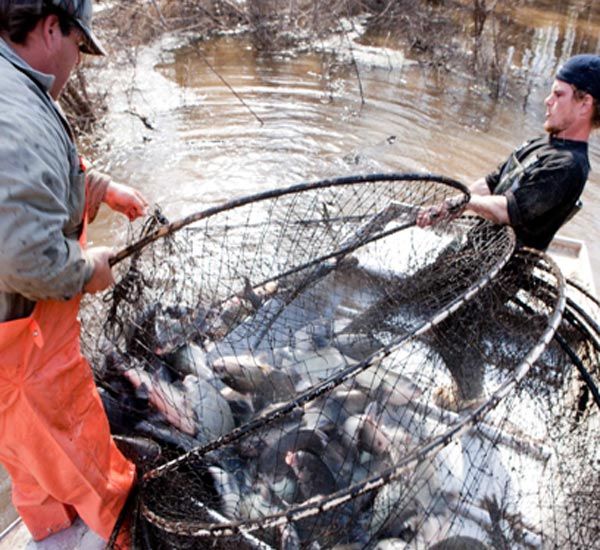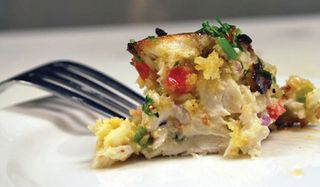New Weapons Against Invasive Carp: Knife and Fork

Invasive, plankton-sucking Asian carp might become less of a menace, some suggest, if we ate them for dinner.
These invasive species – which include the flying silver carp, which has injured boaters with its acrobatics – are believed responsible for declines among native fish within the Mississippi River system, and the fear they may establish themselves in the Great Lakes has prompted a national plan to control them.
In the United States they have been poisoned, and kept at bay with an electric barricade. But elsewhere in the world these fish make for popular meals. So why not try eating them?
Well, if you've ever bitten into a cooked one, you'd know they are notorious for the load of bones hidden in their meat. There is also an image problem that comes along with the word "carp."
In a multi-part YouTube video, Duane Chapman, a research fisheries biologist with the U.S. Geological Survey, demonstrates how to fillet the fish and handle the remaining bones within its "white, flaky and mild" meat, which he says is more like cod than like the common carp.
To Louisiana-based chef Philippe Parola, the meat is "between scallops and crab meat." He has devised his own technique to debone the fish and has a plan to rebrand them as "silverfin" and popularize them as a low-cost, healthy, pre-cooked, flavored product for picky American consumers. [Why Are Asian Carp So Fearsome?]
Carp basics
Sign up for the Live Science daily newsletter now
Get the world’s most fascinating discoveries delivered straight to your inbox.
Depending on how you count them, there are as many as seven species of invasive Asian carp, which include the common carp, introduced in the 19th century, and the goldfish. The two species that have caused the most fretting are the silver and bighead carp, which are encroaching upon the Great Lakes. (The federal government also includes grass and black carp as need-to-watch species.)
As filter feeders that suck up plankton floating in the water, silver and bighead carp were brought to the United States to clean wastewater-treatment and aquaculture-retention ponds in the early 1970s. Their importers also harbored hopes of marketing them as food, according to Chapman.
In high abundance, these fish can leave behind only the smallest of the floating plants. "What you end up with is very green water with a lot of really tiny plankton in it that are so small the fish can't eat them," he said. "Some of our native fishes that feed on plankton have taken it badly."
These include the gizzard shad and bigmouth buffalo in the Missouri River, he said.
The carp are eaten in Asia and Europe, but catching them is labor-intensive and they do not command high-enough prices to make selling them overseas economically feasible, he said.

Cooking with carp
While carp eaters elsewhere in the world are content to pick out bones, Americans are resistant. So Parola has developed an efficient way to remove the bones and has repackaged the fish as silverfin, the star ingredient in recipes he has created, including "silverfin steak and fresh berries" and "silverfin cakes."
"I did it because I love fishing, I love the outdoors, and l understand the problem, and I really would like to make a difference in this," he said.
Chapman, meanwhile, demonstrates how to make what he calls flying carp wings.
Parola's determination to create a "silverfin craze" promises not only to add items to restaurant menus, but to reduce and manage carp populations, create jobs and improve the quality of fish available in the United States.
This isn't Parola's first venture into cooking with invasives. Roughly a decade ago, he lent his hand to an attempt to popularize the meat of nutria, an invasive, semi-aquatic rodent blamed for damaging fragile Louisiana marshes.
Official strategy
Other chefs and conservationists are also exploring ways to serve and promote Asian carp. This strategy, to control the population by creating an appetite for them among Americans, is part of the national official action plan to control the spread of these fish and keep them out of the Great Lakes, where it is feared they could alter the ecosystem and harm native fish. The plan includes strategies like releasing sterile carp to reduce reproductive success, strengthening an electrical barrier system to keep them out of Lake Michigan and investigating poisons that could be used to kill them (known as piscicides).
Eating invasive species is not a cure-all and comes with its own set of risks, according to Chapman.
Demand for the species in question could prompt entrepreneurs to spread the species to new places, and so aggravate the problem. A market could also tie people's livelihoods to the invader, creating resistance to any attempts to eradicate the species, he said.
In the case of Asian carp, attempts to create a market look promising. In China, where the fish are native and a popular food, the fish are often considered overharvested. What's more, there are few new, habitable places in central North America – with the possible exception of the Great Lakes – where the Asian carp could establish themselves, according to Chapman.
"It is a judgment call," he said. "Twenty years down the line we will know whether it was a good idea or not."
You can follow LiveScience senior writer Wynne Parry on Twitter @Wynne_Parry.












